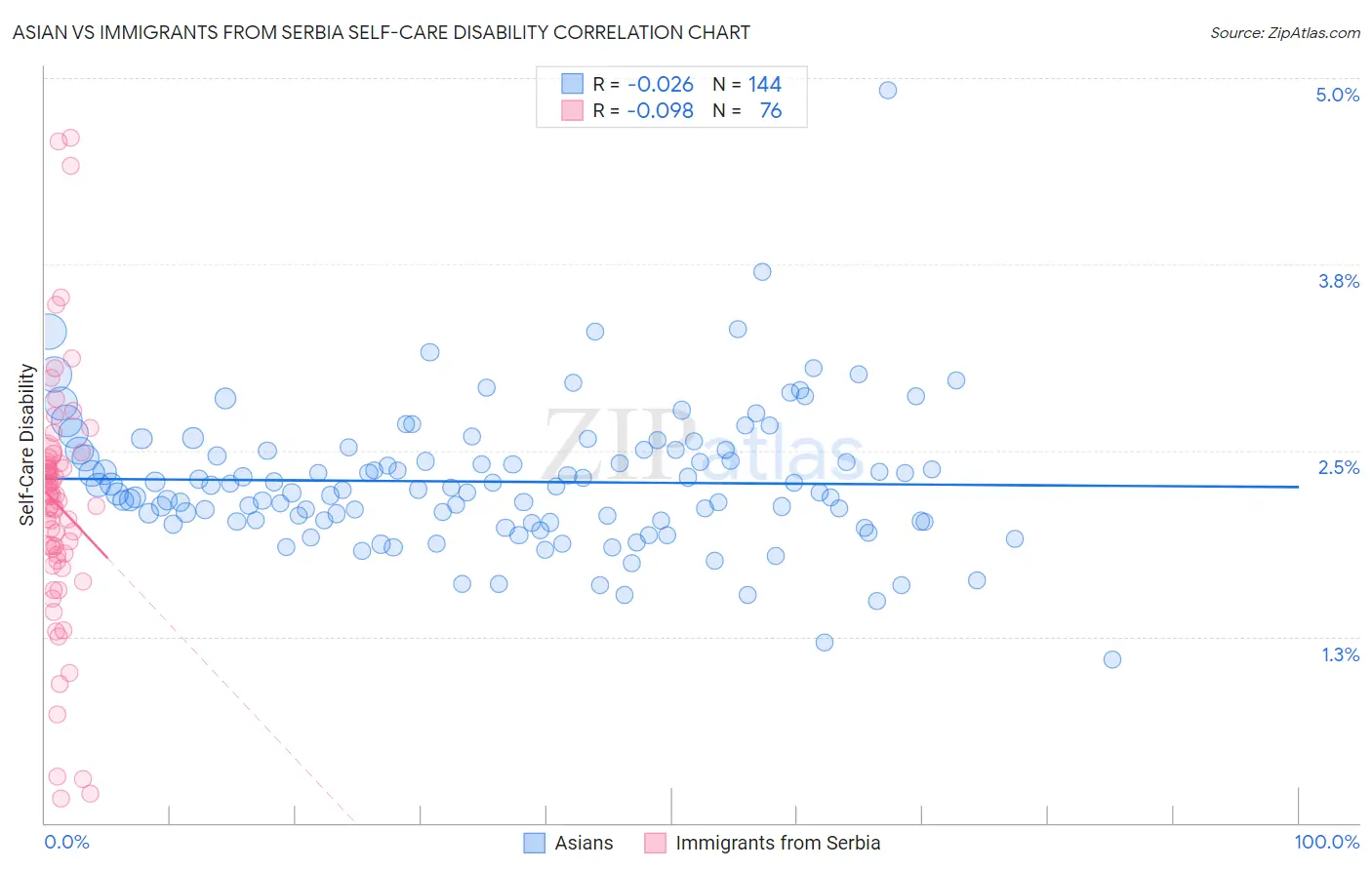Asian vs Immigrants from Serbia Self-Care Disability
COMPARE
Asian
Immigrants from Serbia
Self-Care Disability
Self-Care Disability Comparison
Asians
Immigrants from Serbia
2.3%
SELF-CARE DISABILITY
99.2/ 100
METRIC RATING
71st/ 347
METRIC RANK
2.3%
SELF-CARE DISABILITY
99.6/ 100
METRIC RATING
52nd/ 347
METRIC RANK
Asian vs Immigrants from Serbia Self-Care Disability Correlation Chart
The statistical analysis conducted on geographies consisting of 549,189,639 people shows no correlation between the proportion of Asians and percentage of population with self-care disability in the United States with a correlation coefficient (R) of -0.026 and weighted average of 2.3%. Similarly, the statistical analysis conducted on geographies consisting of 131,686,608 people shows a slight negative correlation between the proportion of Immigrants from Serbia and percentage of population with self-care disability in the United States with a correlation coefficient (R) of -0.098 and weighted average of 2.3%, a difference of 1.1%.

Self-Care Disability Correlation Summary
| Measurement | Asian | Immigrants from Serbia |
| Minimum | 1.1% | 0.16% |
| Maximum | 4.9% | 4.6% |
| Range | 3.8% | 4.4% |
| Mean | 2.3% | 2.1% |
| Median | 2.2% | 2.2% |
| Interquartile 25% (IQ1) | 2.0% | 1.8% |
| Interquartile 75% (IQ3) | 2.5% | 2.4% |
| Interquartile Range (IQR) | 0.47% | 0.61% |
| Standard Deviation (Sample) | 0.47% | 0.82% |
| Standard Deviation (Population) | 0.47% | 0.82% |
Demographics Similar to Asians and Immigrants from Serbia by Self-Care Disability
In terms of self-care disability, the demographic groups most similar to Asians are Immigrants from Northern Europe (2.3%, a difference of 0.040%), Immigrants from Zaire (2.3%, a difference of 0.070%), Immigrants from Norway (2.3%, a difference of 0.070%), South African (2.3%, a difference of 0.16%), and Immigrants from Argentina (2.3%, a difference of 0.19%). Similarly, the demographic groups most similar to Immigrants from Serbia are Kenyan (2.3%, a difference of 0.020%), Australian (2.3%, a difference of 0.030%), Argentinean (2.3%, a difference of 0.080%), Immigrants from France (2.3%, a difference of 0.14%), and Immigrants from Eastern Asia (2.3%, a difference of 0.18%).
| Demographics | Rating | Rank | Self-Care Disability |
| Kenyans | 99.7 /100 | #51 | Exceptional 2.3% |
| Immigrants | Serbia | 99.6 /100 | #52 | Exceptional 2.3% |
| Australians | 99.6 /100 | #53 | Exceptional 2.3% |
| Argentineans | 99.6 /100 | #54 | Exceptional 2.3% |
| Immigrants | France | 99.6 /100 | #55 | Exceptional 2.3% |
| Immigrants | Eastern Asia | 99.6 /100 | #56 | Exceptional 2.3% |
| Immigrants | Belgium | 99.6 /100 | #57 | Exceptional 2.3% |
| Immigrants | Cameroon | 99.6 /100 | #58 | Exceptional 2.3% |
| New Zealanders | 99.5 /100 | #59 | Exceptional 2.3% |
| Immigrants | Japan | 99.5 /100 | #60 | Exceptional 2.3% |
| Palestinians | 99.4 /100 | #61 | Exceptional 2.3% |
| Egyptians | 99.4 /100 | #62 | Exceptional 2.3% |
| Mongolians | 99.3 /100 | #63 | Exceptional 2.3% |
| Swedes | 99.3 /100 | #64 | Exceptional 2.3% |
| Brazilians | 99.3 /100 | #65 | Exceptional 2.3% |
| Immigrants | Argentina | 99.3 /100 | #66 | Exceptional 2.3% |
| South Africans | 99.3 /100 | #67 | Exceptional 2.3% |
| Immigrants | Zaire | 99.2 /100 | #68 | Exceptional 2.3% |
| Immigrants | Norway | 99.2 /100 | #69 | Exceptional 2.3% |
| Immigrants | Northern Europe | 99.2 /100 | #70 | Exceptional 2.3% |
| Asians | 99.2 /100 | #71 | Exceptional 2.3% |